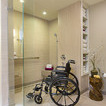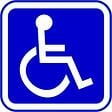Aging in place construction and accessible home remodeling has become synonymous with handicap accessible home design and modification during our lifetime. If you have been paying attention to the medical news concerning our society you are well aware we are living longer than just a few decades ago. As a result, our senior populations are expanding and most people will experience health issues that are most common among the elderly. Most seniors will reach a point in their lives when they require specialized home environments to safely retain their independence. Home modifications can be used to accommodate anyone from people with mobility impairments to those with vision loss, hearing loss, or even cognitive or developmental disabilities. Accessibility home modifications or wheelchair accessible bathroom remodeling in Austin will allow anyone with limited mobility within your home to feel more empowered and independent. The extent of a customized accessibility design is dependent upon the activity level of the person needing the modifications.
Interior modifications can include adding grab bars or handrails throughout the home, lowering upper cabinets and counter tops to universal design heights, adding non-slip flooring, widening hallways or installing stair lifts, and widening doors to a clear 32" width. You might also consider lowering light switches and thermostats and installing easier to use door knobs. You should try to provide a clear barrier free path or accessible route to the most visited areas of your home like a disability access bath.
Modifying your bathroom for ADA compliance following practiced wheelchair accessibility guidelines is a great place to start any universal remodel. This will provide access to both wheelchairs and walkers. Furthermore, you can help avoid many future injuries. Any wet area like the bath is the most dangerous of all your home's surrounding living space and is the most common area for falls and slips. Simply getting in or out of the tub or shower, using the toilet and sink, or just maneuvering over wet surfaces can be hazardous to your health. Installing properly positioned grab bars to increase safety is a great place to spend your money on a limited budget around the shower, toilet, and tub.
The Top Five Items To Include When Considering An Accessible Bathroom Design
1. Vanity Sink Accessibility
Wheelchair Accessible bathrooms today contain stylish ADA vanities set at a universal height of 34 inches with clear knee spaces. Plan on 27 inches of vertical clearance for a wheelchair. The sink faucets must be easily controlled by either wrist handles or levers. The faucets can be fitted on the side of the sink to make them easier to reach. Or install infra-red faucets that detect motion. Hang the mirror low enough for a seated person to see themselves, and tip the top of the mirror out. Bathroom vanities with universal height cabinet tops and open knee spaces are taking over the marketplace. These new residential vanities do not need to look institutional. They can be designed like any other piece of fine furniture. Scalding must be guarded against by using either insulating pipe wrap or a removable panel for the plumbing.
2. Toilet Accessibility
Toilets are available in comfort heights eliminating the deep knee bend needed for seating. Grab bars should be installed on at least both sides of the toilet. Ideally, the toilet should be positioned between two support bars 36 inches apart. A toilet seat 17 inches off the floor is a more comfortable height for everyone. Creating a toilet within an open area and not a closet is much more accessible. Elevated or special toilet seats are available with a heat feature and some have the ability to self close or have a night light. A more expensive bidet/toilet is available but an add on bidet attachment to a regular toilet can be handy.
3. Bathing Facilities
Curbless roll in showers that are 5 feet wide and 3 feet deep having a 36" clear entrance are advised for everyone. The shower should contain at least a shower wand on a sliding bar for varying heights of use along with a regular shower head and control if desired. Installing fixtures with a scald guard or lowering the temperature at the water heater is a must to prevent burns. Folding seats in the shower are useful if caretakers are ever involved and they are much safer than a free standing shower seat which can fall over. Grab bars around the bath and especially in the shower should be used while non slip floor covering should always be considered. Walk in tubs are also a consideration but some people get chilled while the tub is draining. Install the slider bar for the hand held shower hose and head 4 feet off the floor so that the head can slide up to 6 feet high. Always use a shower valve that is thermostatically controlled and pressure-balanced to prevent scalds. If you desire a full body wash, you can include a regular shower head as well.
4. Safety and Accessibility
Always choose fixtures and fittings that are easy to control with a single hand motion or a closed fist. Motion controlled sensor fixtures are also a possibility when specifying finishes. Provide easily accessible storage compartments with pull out shelving eliminating architectural barriers by not using doors on the cabinetry. Always consider the individual needs of the occupant and find the best placement of any reachable items within their reach distance of 24". Fully consider where the best access is for all accessories such as robe hooks, towel bars, paper dispensers, soap dishes, toothbrush holders, shower shelves. The distances and clearances required will be dictated by the user and not by an accepted general outline. With falls in the wet area of the bathroom being such a great concern, a non slip tile floor should be installed without placing loose rugs in the general area. All doors should have levers instead of door knobs. The Americans with Disabilities Act requires a 5-foot turning radius for a wheelchair. But if space is tight, remodelers may be able to make do with less. "(The 5-foor turning radius) may not always be needed, especially with an electric chair, which will easily turn in a tighter space.
5. Lighting
Natural lighting is always better for anyone using the bath. Adequate task lighting in the shower, dressing area, and vanity vicinity should be installed. Lowered switches at around 48" above the floor in reaching distance should control all the lighting. You can install switches with a push button or large toggle that doesn't require a pinching motion to turn on and off. Outlets that are ground protected should be installed at 18" above the floor.
A walk in bath tub containing a water tight door can provide an easy alternative for people with mobility issues who cannot navigate over bathtub walls. The main complaint for these very expensive tubs is that the user must sit there soaking wet and getting cold for a couple of minutes while the tub drains before they can open the door. Another alternative to consider is a walk in shower design which has the option of having a door. The shower door is not needed if the shower is designed properly protecting the adjacent bath floor areas from becoming drenched and hazardous. Any door is just another barrier to negotiate along a designated route for a person with mobility issues. If a wheelchair is needed for mobility, a roll in or transfer shower should be of consideration. A roll in shower is perfect for the person who wants to have a shower but doesn't have the strength to stand in the shower. On the other hand, a transfer shower enables a wheelchair user to move from the wheelchair or walker onto a sturdily mounted seat contained within the shower area. Again this will be determined by the shower user's mobility limitations. A curbless or non-threshold shower entrance is a superior design for gaining access to the walk in shower but it must be correctly designed for drainage. A curbless shower does not mean a shower door cannot be incorporated into the design.
A wall mounted sink can add accessibility to a bathroom by adding additional free space underneath the sink. This allows access with either a wheelchair or bench. Installing a single handle or hands free faucet can ease the burden of those with dexterity issues. Since a wheelchair bound person might bring their legs or the lower part of their body in contact with the plumbing below the sink, it is very important to insulate all the plumbing pipes to protect the user from scalds while the sink is in use.
Standing and seating is taken for granted by most everyone but for those with strength, balance, and mobility issues it can be a difficult task. This is why the toilet has to be a great consideration when designing an accessible, secure, and safe environment. Not only will it help prevent injury but the optimal accessibility design will help preserve an individual's dignity by extending their ability to function independently. Toilets should be of the correct comfort height and be equipped with the proper seat that allows for easy sitting and standing. Toilet seat lights can very helpful while they provide light at night or in darker rooms to help with depth perception and also light the toilet area to prevent trips and falls.
If you hire an experienced building remodeling contractor with infinite knowledge of accessibility home modifications they will be able to help you make the right ADA remodeling choices. These will include the improvements offering the most service to the individual with mobility issues. Talk to your contractor about the disability and the activity level of the person needing the modifications. Together you can arrive at a custom solution for your accessible home design.
A Wheelchair Accessible Bathroom

Aging in place home modifications are available through T-Square Company in the Austin area. We have an A plus rating with the local BBB and have over 30 years of remodeling experience. We are additionally a certified aging in place specialist offering complete aging in place services. Each design/build situation will be customized to fit your personal needs increasing your accessibility. Call 512-444-0097 today to begin the accessible second chapter of your life while remaining safe and secure in your existing home. CAPS #1636580













